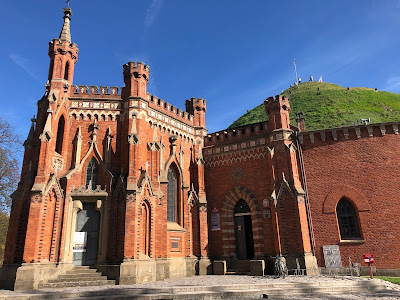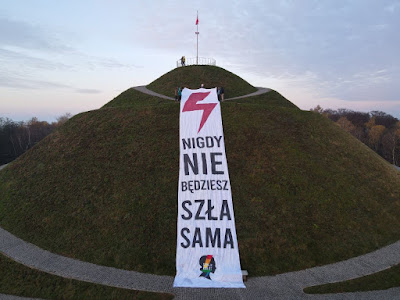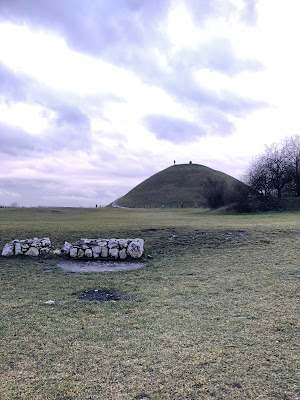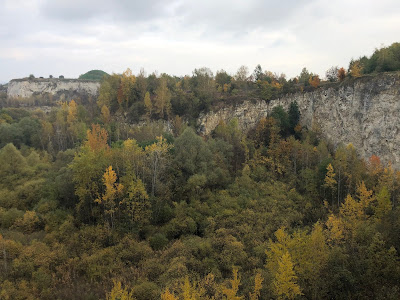There are four mounds in Krakow and this week Cameron and I finally went out in search of the fourth and final one.
No one really knows what the mounds were for. Some hypothesize they were constructed as part of the city's defense mechanism, others say they are just memorial mounds. There's also no consensus about when the oldest were erected- some say the 8th century, others say the 1st or 2nd century. It's probably no surprise that there is also some uncertainty about who built them- it might have been Celts or Slavs, but the modern ones at least were built by the residents of the surrounding communities as tributes and memorials.
Since Cameron moved to Krakow about one month before I did, he is the one who introduced me to the mounds. I had never heard of anything referred to as a "mound" before, other than perhaps a large ant hill, so I had no clue what to expect. Upon first sight, my thought was "woah!"
My first mound introduction was Kościuszko Mound. It is the most popular one since it is the closest to downtown and once you know to look for it you can spot it from many areas around town. It's also the only one fortified by a barrier wall, which makes it look more regal and imposing than the other mounds, even though it is not the largest (34 meters tall) nor the oldest (finished in 1823). The mound was constructed in honor of Tadeusz Kościuszko, a beloved military leader (who for some reason fought in the US Revolutionary War, become chummy with Thomas Jefferson, and made the future US president the executor of his will). I think this site is one of the better ones for a little more information.
Because of it's visibility from town, it's not uncommon to see a long ribbon-like flag running down the mound's slope. For Poland's Independence Day last week there was a red and white patriotic display which was then replaced a few days later with a Woman's Strike message. Although I feel that I can confidently say I've visited the mound, I've never actually climbed it. It's a small fee (maybe only 14 PLN/ 4 USD) but my excuse has been I will wait to pay to go up when I have visitors to take with me.
Surrounding Kościuszko Mound is a fortified wall and this small cathedral.
This model sits outside of the paid area of the mound.
Kościuszko Mound is in the Wolski Forest. There are some really nice trails for hiking, running, and biking so you will see a lot of people hanging around on a nice day.
I know this is not a great quality photo, but just right of center you can see some lights on the horizon which are the Kościuszko Mound lit up.
This is not my photo, but it was sent to me by a women's solidarity texting group I'm part of. The banner translates to "you will never go alone."
Piłsudski Mound (aka Independence or Freedom Mound) is also in the Wolski Forest and there are many trailed routes you can take to connect this mound with the former one. It is the highest point in Krakow, and at 35 meters high it is also the tallest of the mounds. Constructed between 1934-1937, it is also the newest of the mounds. According to the UNESCO World Heritage Center, it was built using earth from WWI and WWII battlefields and "commemorates the Polish struggles for independence and the Polish pre-WWII marshal, Józef Piłsudski." If you want to learn more about Józef Piłsudski, I recommend checking out this site.
Another name for this mound is Mogiła Mogił- "Grave of Graves." As the mound was built by regular citizens, people around Poland brought earth from the battleground sites using special urns. It's believed that dirt from over 3,600 sites is included in the mound, including earth from Józef Piłsudski's mother's grave. According to Discover Crakow, tens of thousands of people wanted to help and pay tribute, which is largely why they got such diverse dirt.
At the foot of Piłsudski Mound.
The first time I visited was on a sheepdogging adventure with Cameron last February.
There weren't any leaves on the trees in February, but if you look to the north you see some agricultural fields and a small irrigation lake.
I really like the stone pathways going up this mound.
I went back with a friend in October, and you can tell the mound was a lot greener than in February.
The views were also a lot more lush in October. On this side of the mound (I think the west side) is a park and playground.
Views from the other direction- some of the trees were starting to turn yellow but trees did really reach their peak fall colors until late October this year.
Krakus Mound is the one I visit most regularly since it's only about half an hour walk from my flat. It is the oldest structure in Krakow and thought to be the resting place of Krakow's founder, King Krak. There have been excavations of the mound which uncovered a solid wooden core, artifacts from the 8th and 10th centuries, and a child's skeleton but no human remains that can be attributed to the King. Standing at 16 meters tall, it apparently used to be ringed by four smaller mounds but those were torn down in the 19th century to make a city wall.
Approaching Krakus Mound for the first time. I'm not sure what the stone piles are that are smattered around the mound but perhaps they are remnants of the defense wall that replaced the four smaller mounds that used to exist here.
The steeples from various churches and cathedrals are the most prominent markers on the horizon.
Unfortunately with just a small turn of the head you also see some large smoke stacks and industrial buildings which are not quite as picturesque.
View 1: January
View 2: October
I'm not entirely sure why the surrounding grounds are so uneven; maybe it's remnants from the excavation.
Behind Krakus Mound is this quarry, which was largely worked on by prisoners in the nearby concentration camp. The structures you can see inside the quarry are included in the film Schindler's List.
You can walk all the way around (and in) this quarry and get pretty good views of the mound.
Lastly is Wanda Mound- the subject of our sheepdogging adventure earlier this week. Wanda is pretty far (a minimum of 45 minute bike ride from my house) and is the smallest (14 meters) of the four mounds. The mound is inspired by the legendary Princess Wanda, who drowned herself in the Vistula River to avoid marriage with a German prince. The mound is close to the part of the river where her body was found (although not that close-it's at least 3km away from where the Vistula flows these days) and apparently houses her tomb; before being called Wanda Mound, it used to be referred to as "the Grave".
Princess Wanda was the daughter of King Krak, and the two mounds may be connected in honor of that relationship. Every year, on 4 November and 6 February you will see the sun set over Krakus Mound if you stand atop Wanda Mound. You'll experience the same phenomenon over Wanda Mound if you visit Krakus Mound on 2 May or 10 August. That leads some to think that these two mounds were used as a form of calendar. The exact timeline of construction of these mounds is unknown, but it seems like somewhere between the 6th and 10th centuries is a fair guess, which would mean they were likely constructed by Celts or Slavs, giving more credence to the astrological theory- those dates match up with the approximate periods for various Slavic holidays.
A small side note from me- when Cameron and I visited I looked really hard for other Krakow landmarks. I specifically was looking for other mounds on the horizon, but to no avail. Maybe it was a little smoggy or maybe I just didn't know what I was looking for but I did not see Krakus Mound.
Wanda sits within a small park, but there aren't many walking trails as it's largely surrounded by train tracks and large roads.
There is a decent view in one direction, but good luck seeing the other mounds on the horizon!
Small monument at the top of the mound. I was surprised at how many other people were on top when we went mid-week.
Wanda definitely felt the most rugged of the mounds. There was just a narrow animal track-type trail weaving up it.
One great thing about the mound was some oversized wooden lounge chairs to sit at and gaze up at the mound.
Remember when I said there were four mounds in Krakow- well upon doing some research for this post I learned that there are in fact five mounds, and there actually used to be a sixth, too. There's not much information about the John Paul II Mound other than it is the newest (raised in 1997) and smallest (only 7 meters). It seems like it is on some church grounds and "commemorates the sixth pilgrimage of the Polish Pope to his homeland" (www.krakow.pl). I would like to write it off but I know it will nag at me until I visit it. Luckily, it's pretty close to a few parks I really like and my favorite ice cream shop so chances are I will be over there soon enough...that is unless the nag motivates me to head out this weekend.
I'm not able to find much about the non-existing mound, Esterka, either and the "facts" I do find are contradicted across various websites. The general legend is that Ester was the mistress of King Kazimierz the Great. Upon hearing of his infidelity, Ester jumped out of a window–I guess she didn't know she was the mistress? The mound was erected somewhere between the 14th and 18th centuries at the site that was expected to be her grave, and then was bulldozed in the 1950s, '60s, or '70s to make way for the WKS Wawel football club stadium. Like I said, the information available is quite inconsistent. However, Ester seems like she was a good force in Krakow's history. King Kazimierz is known for welcoming in a large Jewish community to Krakow (that's why the historic Jewish district is called Kazimierz) and it seems to be largely due to Ester's influence (en.wikipedia.org).
Apparently, according to a few sites, Krakow is the a record holder when it comes to mound numbes. Some sits say it's the most mounds in Poland, others say in the world, and what constitutes a mound and what other locations are contenders are mysteries to me. Nonetheless, when you visit I will recommend a mound walk at some point during your stay. Not only are they great spots for a picnic with a view but then you can say you climbed a record-making mound–I bet you don't have any friends at home who can say that.
A map of the four main mounds.


























No comments:
Post a Comment